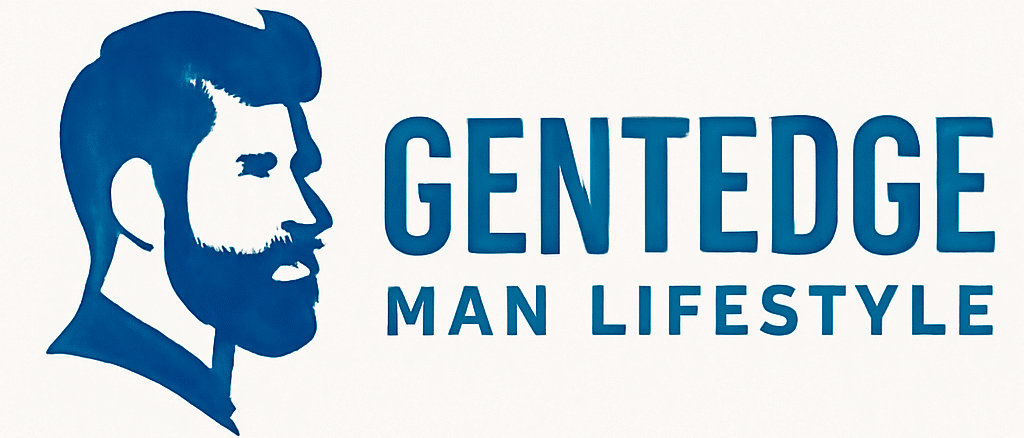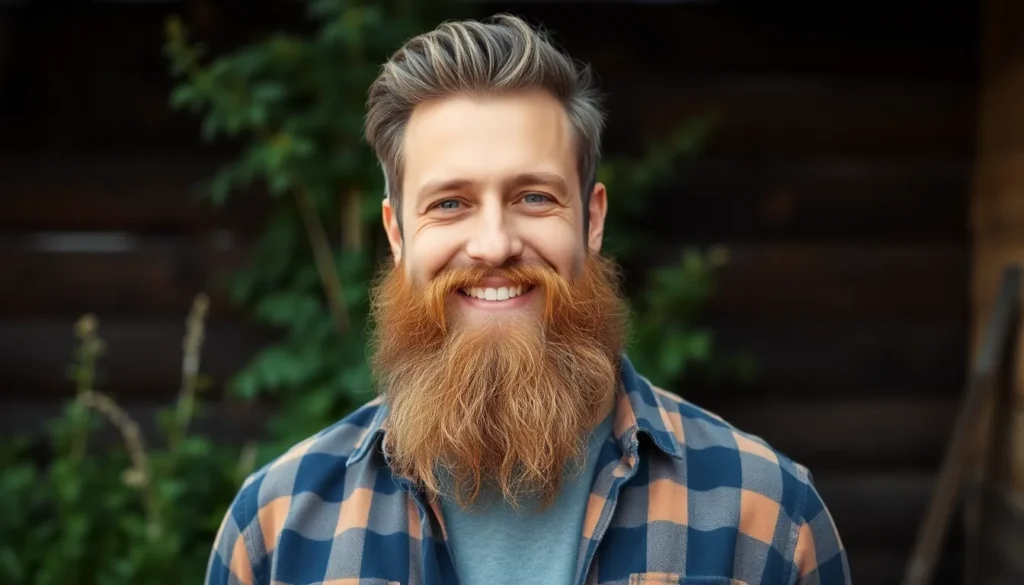Long beards have made a powerful comeback in men’s grooming, transforming from a niche trend into a mainstream style statement. Whether you’re embracing your natural growth or planning to cultivate an impressive mane, we’ve discovered that the right long beard style can completely redefine your masculine appeal and boost your confidence.
We understand that growing and maintaining a long beard isn’t just about letting facial hair run wild – it’s an art form that requires patience, proper technique, and the right styling approach. From the rugged full beard to the sophisticated ducktail, each style tells a different story and complements various face shapes and lifestyles.
Today’s modern gentleman has countless options when it comes to long beard styles, and we’re here to guide you through the most popular and striking choices. Let’s explore how you can transform your facial hair into a powerful style asset that commands respect and admiration.
The Classic Full Beard: A Timeless Long Beard Style
We consider the classic full beard the gold standard of long beard styles for men seeking maximum facial hair impact. This foundational style covers the entire lower face and neck area with dense, even growth that projects strength and maturity.
Maintenance Requirements for Full Beards
Daily brushing becomes essential once your full beard reaches 2-3 inches in length to prevent tangles and distribute natural oils evenly. We recommend using a boar bristle brush each morning to train the hair growth direction and maintain shape consistency.
Weekly trimming sessions help maintain the beard’s outline and remove split ends that can make the style appear unkempt. Professional barbers suggest trimming every 7-10 days to keep the neckline clean and the cheek line well-defined.
Oil application should occur 3-4 times per week to keep the skin underneath moisturized and prevent beard dandruff. Quality beard oils containing jojoba or argan oil penetrate deeply and reduce itching during the growth phase.
Shampooing frequency needs adjustment from daily hair washing to 2-3 times weekly to avoid stripping natural oils that keep long beards healthy. Specialized beard shampoos maintain the proper pH balance for facial hair.
Best Face Shapes for Classic Full Beards
Round faces benefit significantly from full beards as the added length creates vertical lines that elongate the appearance. We’ve observed that men with round faces gain 20-30% more facial definition when sporting well-maintained full beards.
Square jawlines pair naturally with classic full beards since the style complements existing angular features without overwhelming them. The full coverage softens sharp edges while maintaining masculine structure.
Oval face shapes work exceptionally well with full beards because the balanced proportions accommodate the style’s volume without distorting facial harmony. Men with oval faces can grow their beards 4-6 inches without losing aesthetic balance.
Heart shaped faces find that full beards add weight to the lower portion of the face, creating better overall proportion with wider foreheads. The dense coverage helps balance prominent cheekbones and narrow chins effectively.
The Yeard: Growing Your Beard for a Full Year
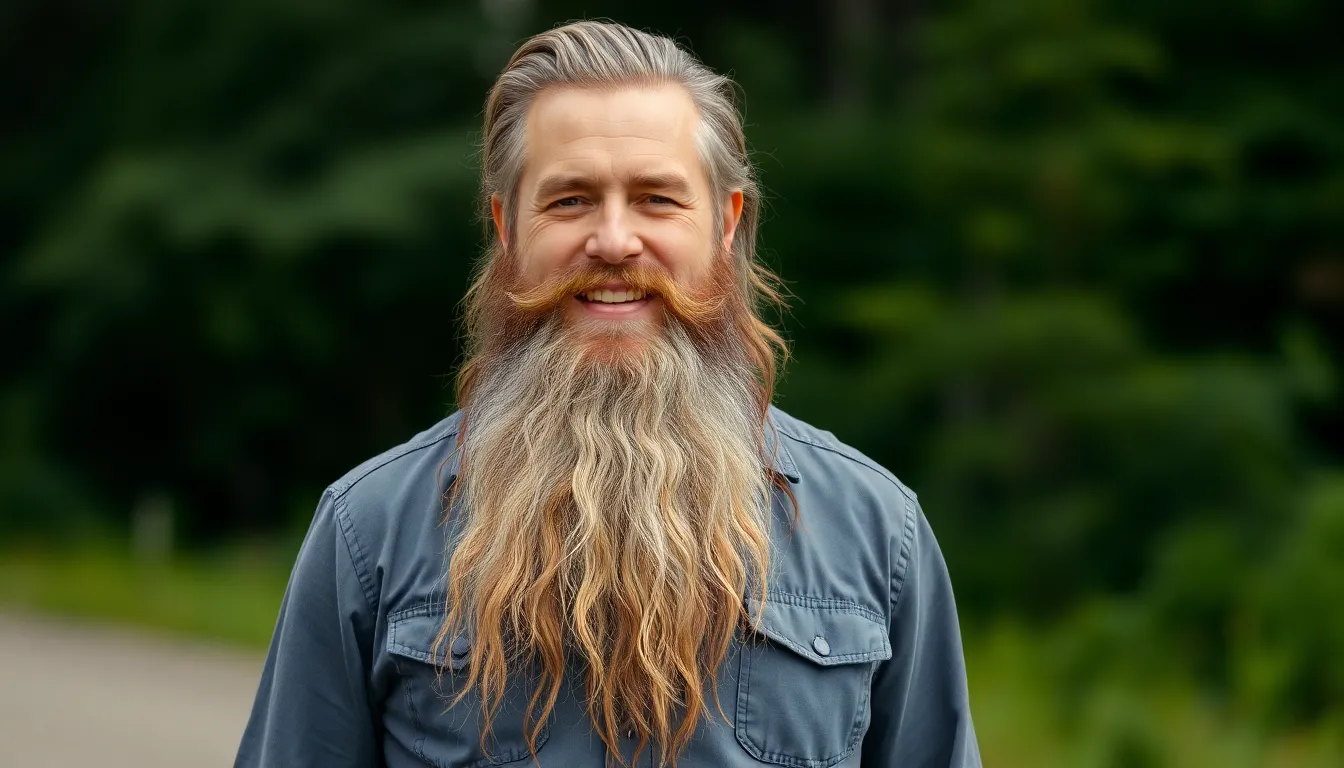
A yeard represents the ultimate commitment to long beard styles, requiring dedication and patience over twelve months. This full-year growing challenge transforms your facial hair into a truly impressive statement piece.
Understanding the Yeard Journey
Starting your yeard journey requires mental preparation for the various growth phases you’ll experience. The first three months present the most challenging period, as your beard navigates through awkward lengths and patchy areas that test your resolve.
Growth patterns vary significantly between individuals, with some men experiencing rapid development while others see gradual progress. Your beard’s texture and density will change throughout the year, often becoming fuller and more manageable after the six-month mark.
Milestone markers help track your progress during this extended growing period. At three months, you’ll notice increased volume and the beginning of your beard’s natural shape. Six months reveals your beard’s true potential, while nine months showcases impressive length that commands attention.
Seasonal challenges affect your yeard’s appearance and comfort throughout the year. Summer heat can make your long beard feel uncomfortable, while winter provides natural insulation that makes the commitment more rewarding.
Tips for Successfully Growing a Yeard
Consistency in your grooming routine becomes essential for maintaining a healthy yeard throughout the year. Daily brushing prevents tangles and distributes natural oils, while weekly beard oil applications keep your facial hair soft and your skin moisturized.
Trimming strategy requires careful planning to maintain your yeard’s shape without sacrificing length. We recommend visiting a professional barber every 6-8 weeks for minor touch-ups that preserve your overall growth goals.
Nutrition support plays a crucial role in your beard’s health during this extended growing period. Protein-rich foods, biotin supplements, and adequate hydration contribute to stronger, fuller facial hair growth.
Sleep quality affects your beard’s growth rate and overall health throughout your yeard journey. Aim for 7-8 hours of quality sleep nightly to support optimal hair follicle function.
Product investment becomes more important as your beard reaches impressive lengths. High-quality beard balms, oils, and specialized combs designed for long beards help manage your growing facial hair effectively.
Documentation of your yeard progress creates a valuable record of your transformation. Monthly photos from different angles help you track growth patterns and celebrate milestones along the way.
The Viking Beard: Embracing Ancient Warrior Style
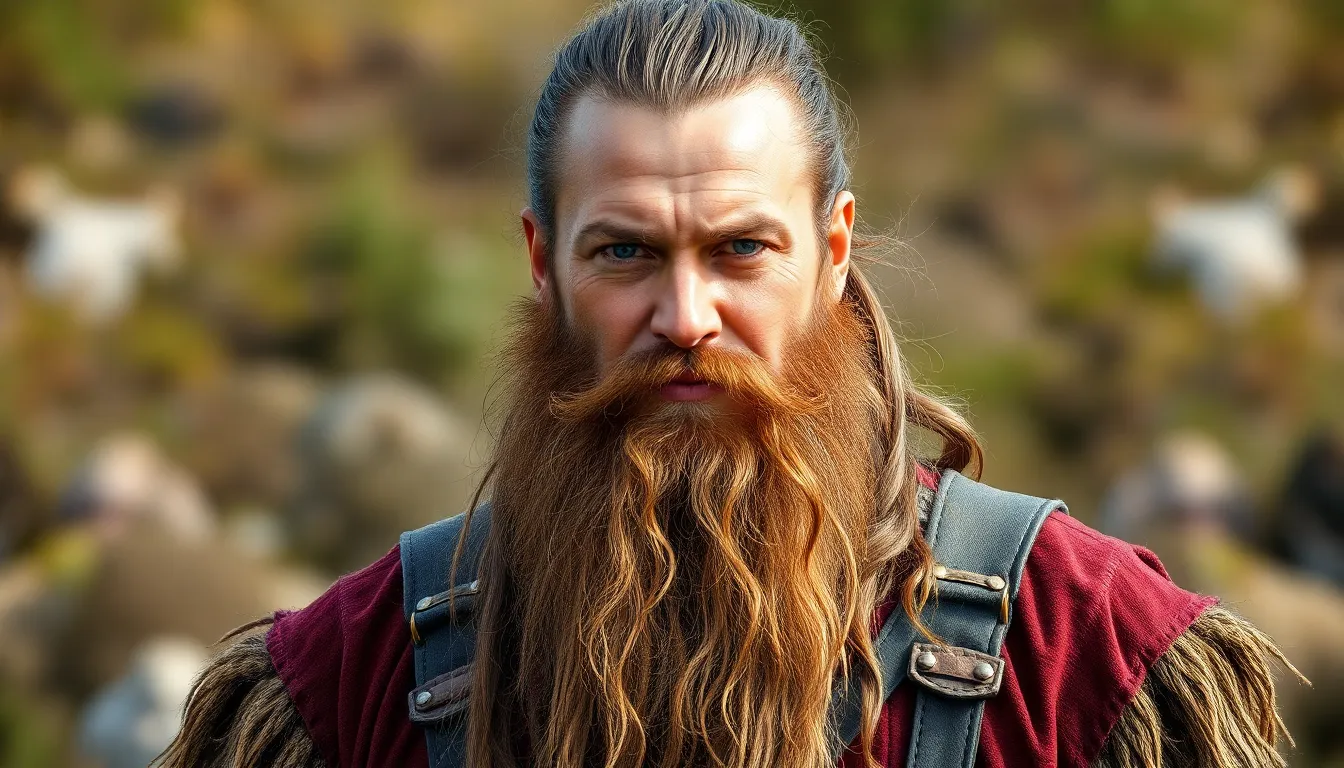
The Viking beard represents one of history’s most iconic facial hair styles, embodying the fierce warrior spirit of Norse culture. We’ll explore how this ancient style has evolved into modern interpretations that capture the same rugged masculinity.
Characteristics of Authentic Viking Beards
Full and thick growth defines the authentic Viking beard aesthetic. Vikings cultivated dense facial hair that connected seamlessly with their mustaches, creating an unbroken wall of hair across the lower face. This style required no gaps between the beard and mustache areas.
Length variations ranged from moderate to long, though Vikings avoided excessively lengthy beards that could hinder combat effectiveness. Warriors often braided their facial hair to keep it manageable during battles and daily activities. These braids served both practical and decorative purposes.
Cultural importance elevated the beard beyond mere fashion. Viking men considered their beards sources of immense pride, investing important time in grooming and maintenance. Insulting another man’s beard could provoke serious conflicts, highlighting the deep cultural significance attached to facial hair.
Grooming standards remained surprisingly high among Viking warriors. Even though their rugged reputation, these men maintained well-kept beards that reflected their status and personal honor within their communities.
Modern Adaptations of Viking Beard Styles
Long Viking beard style suits men blessed with naturally thick facial hair growth. This adaptation works exceptionally well with both short and long head hair, creating a balanced masculine appearance. Growing this style demands considerable patience but delivers a commanding warrior-like presence.
Pointy Viking beard variations feature strategically shaped facial hair that tapers to one or two distinct points at the bottom. Modern versions require regular trimming sessions and quality styling products to achieve the polished, intentional look that distinguishes this style from unkempt growth.
Braided Viking beard options incorporate traditional braiding techniques that Viking warriors used for practical purposes. Contemporary adaptations of this style keep facial hair organized while making a bold fashion statement that honors ancient Norse traditions.
Maintenance requirements for modern Viking styles include consistent grooming routines and proper product selection. These adaptations maintain the essence of original Viking beards while accommodating different face shapes and personal preferences in today’s grooming industry.
The Bandholz Beard: Natural Growth with Purpose
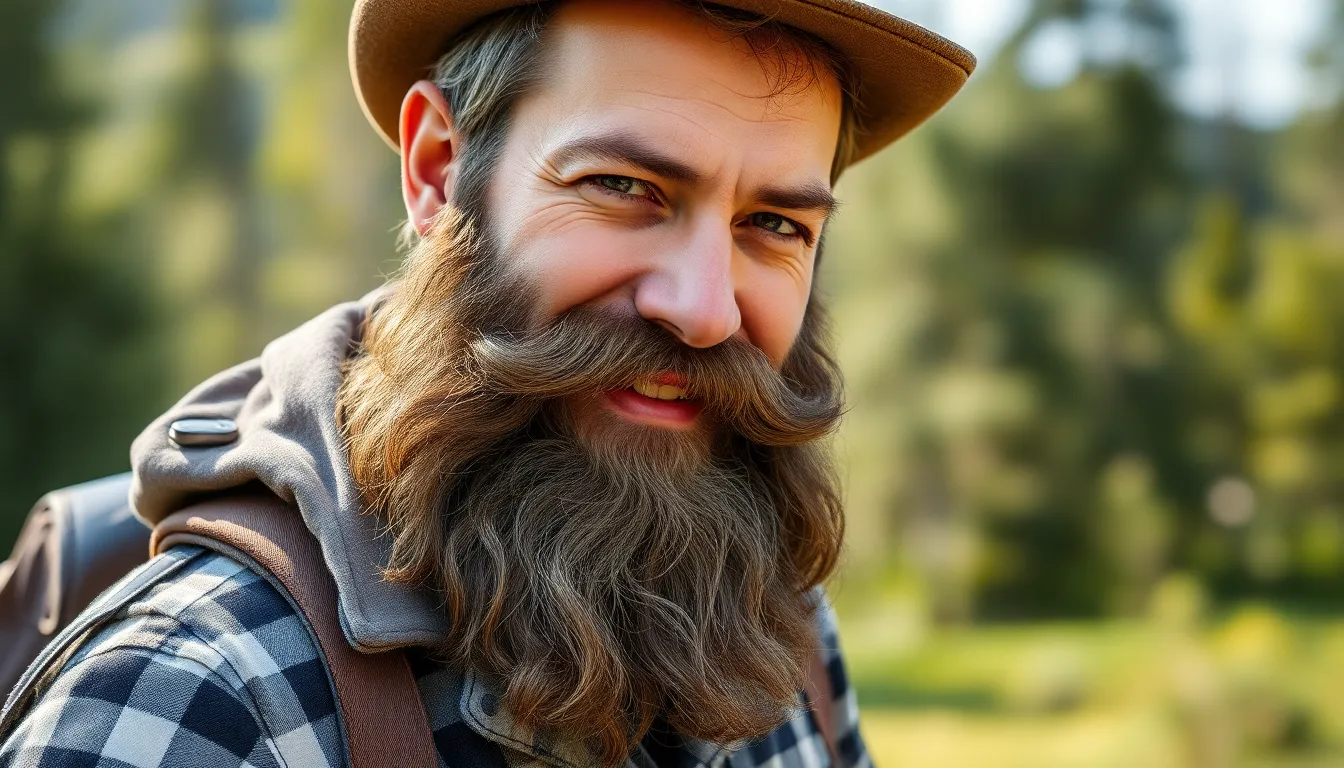
The Bandholz beard represents a distinctive approach to long facial hair that celebrates natural growth over structured constraints. We’re exploring a style that allows unlimited length while maintaining sophisticated grooming standards.
Origins of the Bandholz Style
Eric Bandholz transformed his frustration with corporate grooming standards into a revolutionary beard movement. Corporate environments stifled his passion for facial hair, leading him to leave his traditional job in 2011 to pursue his beardsman vision. Beardbrand emerged from this bold decision, with Bandholz himself becoming the living embodiment of his “urban beardsman lifestyle.”
This iconic style differs fundamentally from length-restricted options like the Garibaldi beard. We see how Bandholz’s personal journey created a beard philosophy that emphasizes authenticity over conformity. His approach challenged workplace norms and redefined professional appearance standards for modern men.
Grooming Techniques for the Bandholz Look
Natural growth forms the foundation of achieving this distinguished beard style. We recommend allowing your facial hair to develop its full potential without aggressive trimming that compromises length or density.
Essential grooming practices include:
- Embrace unrestricted growth while maintaining overall beard health through consistent care routines
- Connect your mustache seamlessly to create the signature full-coverage appearance that defines this style
- Shape strategically by removing only stray hairs and defining edge lines without sacrificing the natural fullness
- Maintain intentional structure using quality trimming tools to enhance the beard’s natural contours
Quality beard oils and brushing techniques become crucial for managing longer lengths. We emphasize that this style requires patience during initial growth phases while rewarding commitment with impressive results. Regular maintenance prevents the common pitfalls of unkempt appearance while preserving the beard’s natural character.
The Garibaldi Beard: Refined Fullness with Shape
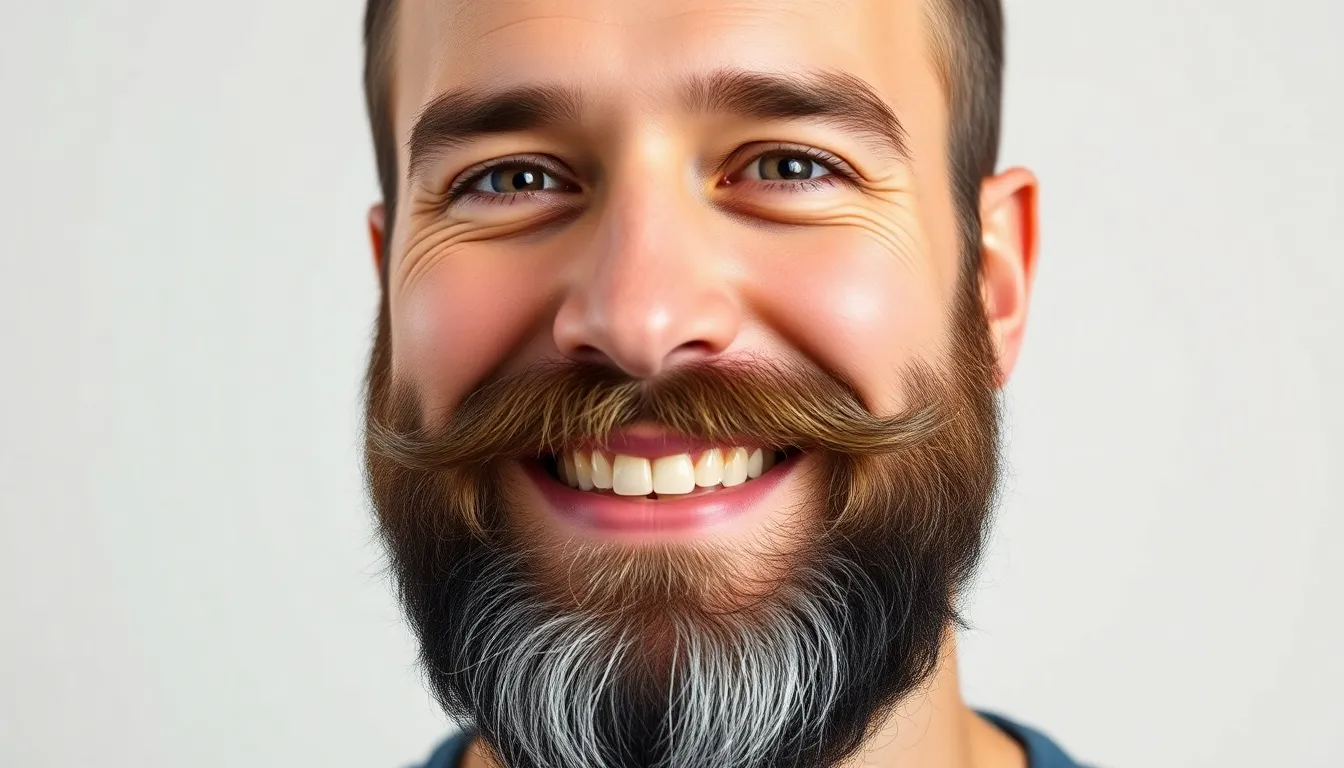
Named after Giuseppe Garibaldi, the 19th-century Italian general renowned for his military achievements, this distinctive long beard style combines substantial fullness with carefully crafted shaping. We consider the Garibaldi one of the most sophisticated long beard styles that balances natural growth with refined grooming standards.
Defining Features of the Garibaldi Style
Substantial length and thickness define the Garibaldi’s commanding presence, with most beards measuring 6-8 inches in length and never exceeding 20 cm. Robust appearance stems from allowing natural fullness to develop while maintaining strategic control over the overall shape.
Rounded bottom edges create the style’s signature silhouette, extending slightly beyond the jawline to frame facial features effectively. This curved foundation distinguishes the Garibaldi from other long beard styles by providing structured elegance rather than wild, untamed growth.
Seamless mustache integration connects thick facial hair with the beard’s body, creating a unified look that projects sophistication. While the beard itself maintains a slightly unkempt natural appearance, the mustache requires precise trimming to preserve the style’s refined character.
Strategic face shape enhancement makes the Garibaldi particularly suitable for oval and rectangular face shapes, as it adds width and creates balanced proportions. Men with these facial structures benefit from the beard’s ability to frame features while maintaining masculine appeal.
Professional Styling Tips for Garibaldi Beards
Balance natural growth with targeted grooming by allowing the beard to develop its characteristic fullness while keeping the mustache meticulously maintained. This contrast between controlled and free-flowing elements creates the Garibaldi’s distinctive aesthetic appeal.
Carry out regular trimming schedules to prevent excessive unruliness while preserving the beard’s robust thickness and rounded shape. Professional barbers recommend monthly shape-ups to maintain the curved bottom edge without sacrificing the style’s natural fullness.
Focus mustache precision through weekly trimming sessions that keep upper lip hair neat and well-defined against the beard’s more relaxed growth pattern. This attention to mustache detail elevates the entire look from casual to sophisticated.
Maintain beard health through consistent oil applications and daily brushing to support the substantial growth required for authentic Garibaldi styling. Quality grooming products become essential when managing the increased hair volume and length that characterizes this refined beard style.
The Ducktail Beard: Sophisticated Length with Tapered Point
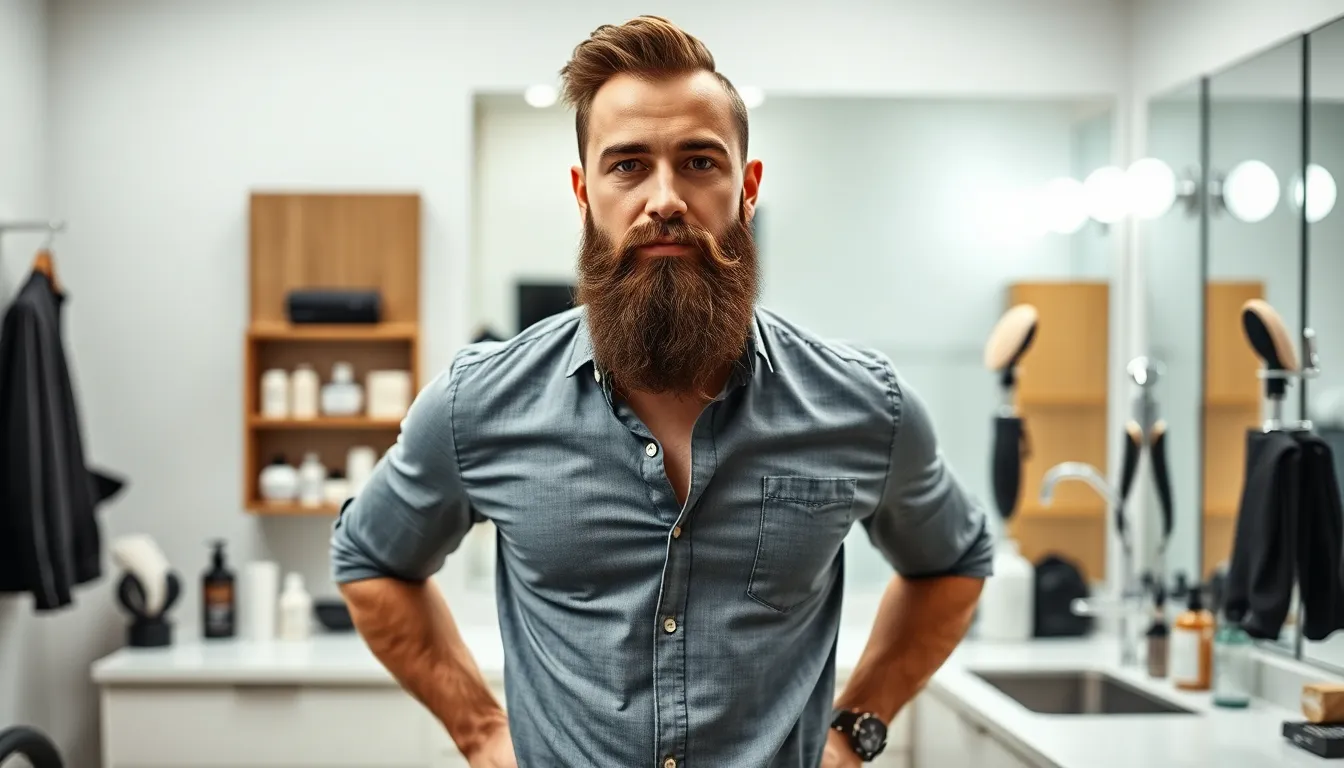
The ducktail beard represents one of the most distinguished long beard styles for men, featuring a sophisticated design that tapers to a distinctive point. This elegant style combines substantial length with refined shaping, creating a duck’s tail appearance that commands attention and respect.
Achieving the Perfect Ducktail Shape
Growing your beard to at least two inches of length at the bottom creates the foundation for this sophisticated style. We recommend combing your beard straight down to establish the natural flow needed for proper ducktail formation. Connecting the sides seamlessly to your sideburns ensures a cohesive look that frames your face perfectly.
Trimming the jawline neatly while avoiding cuts around the chin or below maintains the essential volume needed for the pointed shape. Your beard’s natural growth pattern will guide the formation of the characteristic “V” shape that defines this style. Patience during the initial growing phase allows your facial hair to develop the length necessary for proper ducktail sculpting.
Classic ducktail variations feature full beards with tapered sides that draw focus to the pointed bottom section. Rugged ducktail approaches embrace a bushier texture for men who prefer casual styling options. Sophisticated ducktail trimming keeps hair closer to the face while emphasizing the sharp “V” formation for sleek professional appearances.
Trimming Techniques for Ducktail Maintenance
Maintaining clean necklines and cheeklines requires regular attention with quality clippers or precision scissors. We suggest establishing consistent boundaries that complement your face shape while preserving the beard’s overall volume. Fine toothed combs help guide your trimming sessions and ensure symmetrical results across both sides of your face.
Beard shaping templates provide professional level precision when creating the distinctive ducktail point. The trimmer over finger technique allows for controlled length reduction at the bottom section without compromising the style’s integrity. Regular maintenance sessions every 2-3 weeks keep your ducktail well defined and properly sculpted.
Professional barbers often recommend starting with longer lengths and gradually working toward your desired shape over multiple sessions. This approach prevents overcutting mistakes that could require weeks of regrowth to correct. Quality beard oils and balms support healthy growth while making trimming sessions more manageable and precise.
The Wizard Beard: Maximum Length and Drama
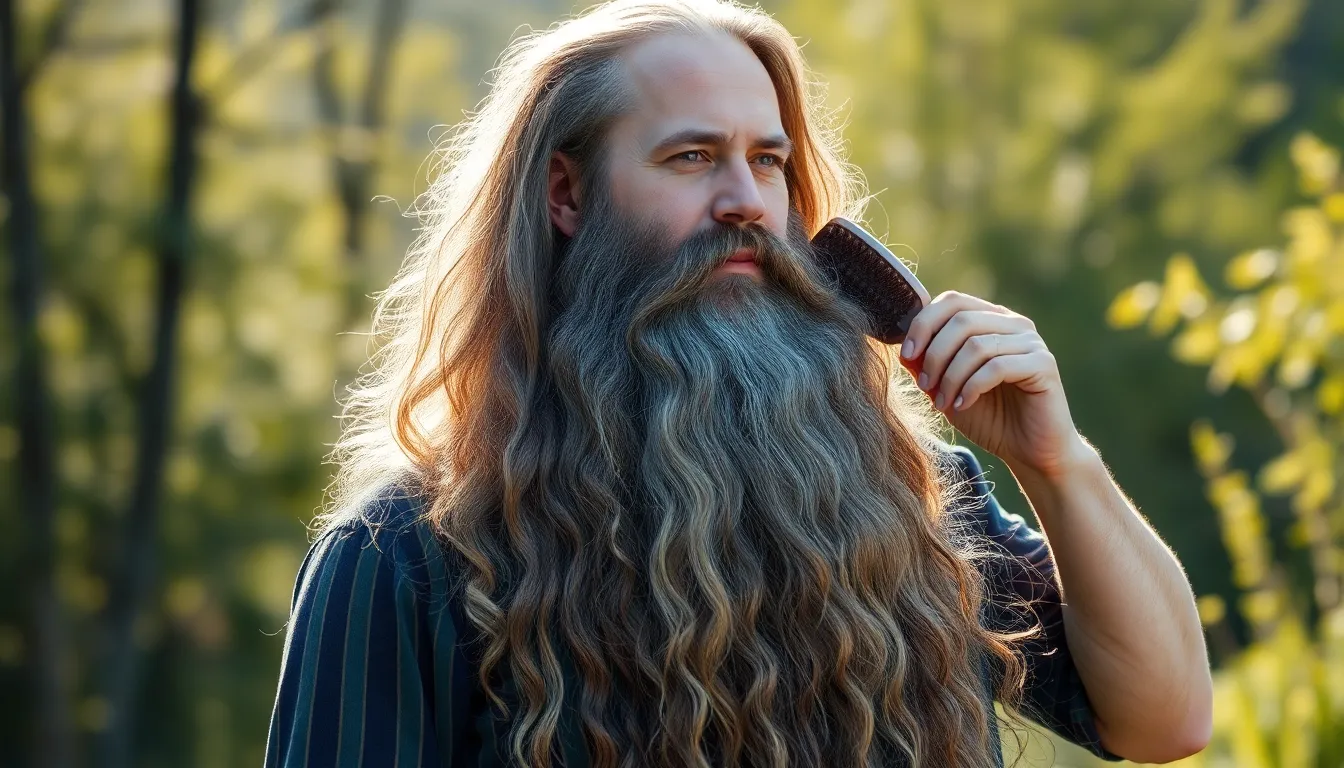
The Wizard Beard represents the ultimate expression of facial hair commitment, extending well past the chest to create a mystical, wise appearance. This ultra-long, flowing style is best suited for men blessed with naturally fast-growing, thick beards who are willing to embrace the journey of maximum length.
Growing Strategies for Extra-Long Beards
Achieving wizard-length facial hair requires strategic planning and unwavering patience. We recommend maintaining consistent hydration through high-quality beard oils and balms, which keep the hair follicles nourished and promote healthy extension. Daily application of these products prevents the brittleness that commonly plagues extra-long beards.
Minimal trimming becomes crucial during the growth phase, as frequent cuts can significantly stunt progress toward maximum length. Instead of regular shaping sessions, we focus on spot treatments for damaged areas only. Protection from environmental damage involves using specialized beard softeners that create a protective barrier against wind, sun, and daily wear.
Diet plays an essential role in supporting the extended growth timeline required for wizard-length beards. Protein-rich foods fuel hair production, while vitamins B and D enhance follicle strength. Sleep quality directly impacts growth hormones, making consistent rest patterns vital for achieving dramatic length.
Care and Protection for Wizard-Length Facial Hair
Maintaining a wizard-length beard demands a comprehensive care routine that goes beyond basic grooming. Regular brushing with a high-quality boar bristle brush prevents the tangling that naturally occurs with extreme length. We recommend brushing sessions twice daily, working from the roots to the tips in smooth, deliberate strokes.
Specialized beard conditioners become non-negotiable for wizard-length maintenance, as standard products lack the intensive moisturizing properties needed for such extensive hair. These formulations penetrate deeply into the hair shaft, maintaining softness and manageability even though the challenging length.
Split end protection requires vigilant attention, as damage spreads quickly through long hair. We trim split ends immediately upon detection, using sharp scissors to make clean cuts that prevent further deterioration. Monthly deep conditioning treatments restore moisture balance and strengthen the hair structure.
Sleeping protection involves silk pillowcases or beard wraps that reduce friction and prevent overnight tangling. During daily activities, we secure the beard when necessary to avoid catching it in clothing or equipment, preserving both length and integrity.
The Lumberjack Beard: Rugged and Naturally Full
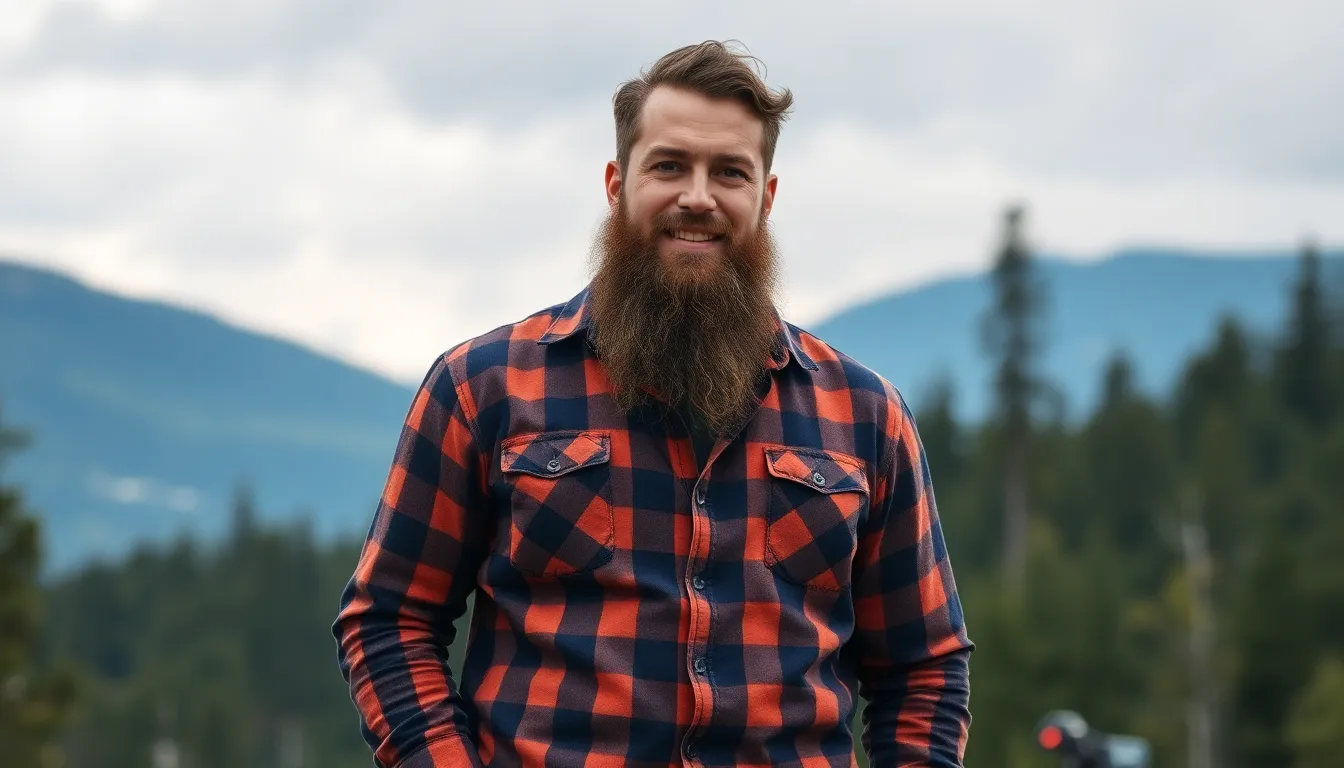
The lumberjack beard embodies the perfect balance between rugged masculinity and controlled growth, making it one of the most sought-after long beard styles for men who want to project strength and outdoorsy appeal.
Embracing the Untamed Lumberjack Aesthetic
Thickness becomes the defining characteristic of the authentic lumberjack beard, creating a naturally full appearance that commands attention. This style suits square and round faces particularly well, as the dense facial hair adds definition and masculine structure to softer features.
Wild growth patterns distinguish the lumberjack from more refined beard styles, allowing for natural texture variations that mirror the rugged lifestyle it represents. We see this untamed quality in the slightly irregular edges and organic fullness that develops over months of dedicated growth.
Outdoorsy lifestyle alignment makes the lumberjack beard ideal for men who work with their hands or spend considerable time in natural environments. The substantial thickness provides natural protection against wind and weather while maintaining a professional appearance that works in both casual and semi-formal settings.
Face shape compatibility extends beyond square and round faces to include oval shapes, though the style requires careful attention to proportions. Men with longer faces should be cautious about excessive length that might elongate their features disproportionately.
Balancing Wildness with Grooming Standards
Daily brushing prevents matting and maintains the lumberjack beard’s healthy appearance, using a quality boar bristle brush to distribute natural oils throughout the hair. This essential maintenance step keeps the thick growth manageable while preserving its naturally wild character.
Occasional trimming maintains shape without sacrificing the beard’s inherently untamed aesthetic, focusing on removing split ends and controlling excessive bulk. We recommend monthly trimming sessions to preserve length while keeping the overall silhouette clean and intentional.
Beard oil application becomes crucial for lumberjack beard maintenance, as the thick, dense hair requires extra moisture to stay soft and healthy. Quality oils penetrate the substantial growth to nourish both hair and skin underneath, preventing the dryness that can make thick beards feel coarse.
Strategic shaping techniques help define the lumberjack’s natural boundaries without over-grooming the style, maintaining clean necklines and cheek borders while allowing the main body to grow freely. This approach preserves the beard’s rugged appeal while ensuring it looks intentional rather than neglected.
Product selection matters significantly for lumberjack beard success, requiring heavier beard balms and conditioning treatments that can penetrate thick, coarse hair effectively. We find that men with this style benefit from weekly deep conditioning treatments alongside their daily oil applications.
Essential Tools and Products for Long Beard Maintenance
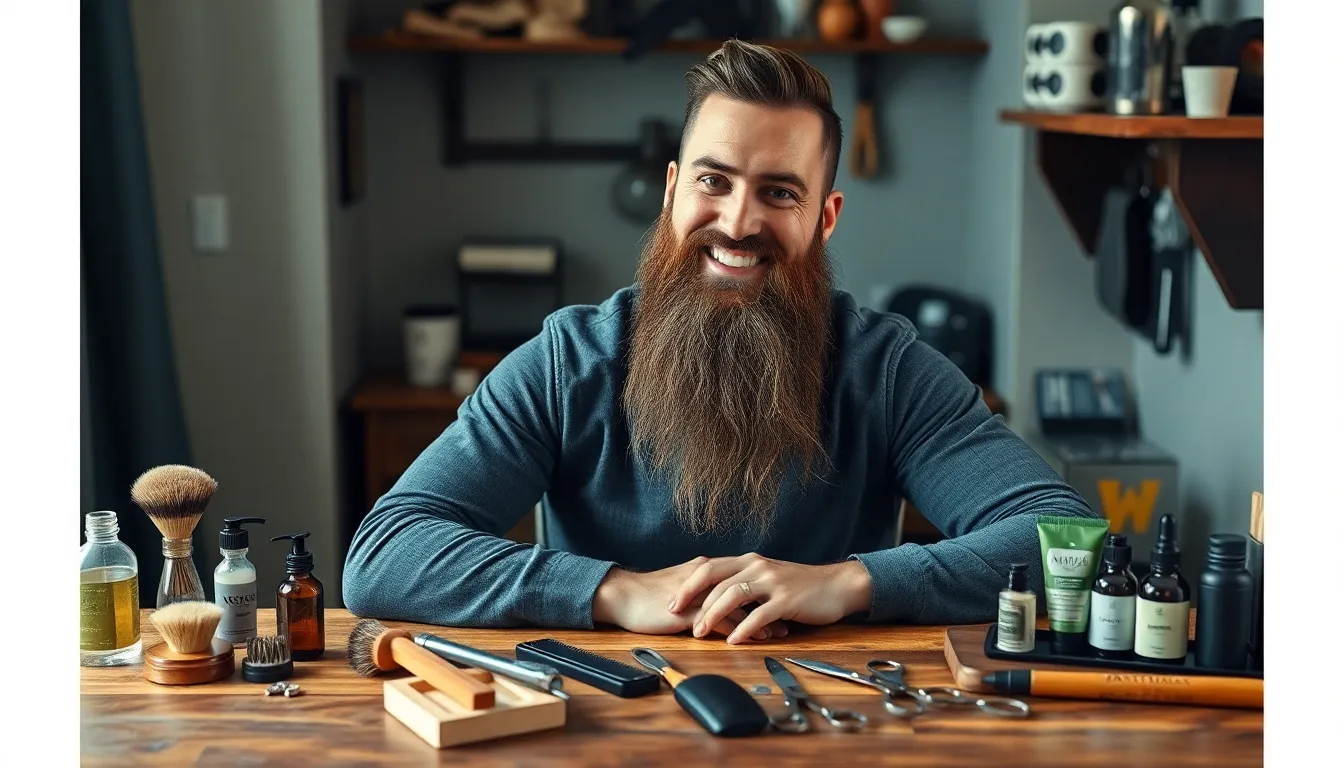
Growing a long beard requires the right arsenal of tools and products to maintain its health and appearance. We’ve compiled the essential items every long beard enthusiast needs for proper grooming.
Must-Have Grooming Equipment
Beard brushes serve as the foundation of any long beard maintenance routine, detangling knots while distributing natural oils evenly throughout your facial hair. Natural boar bristle brushes work best for long beards since they glide smoothly through thick hair without causing breakage.
Quality beard combs help shape and style your long beard with precision, allowing you to create defined lines and smooth out unruly sections. Wide tooth combs prevent snagging on longer hair, while fine tooth combs offer detailed styling control for mustache areas.
Professional scissors or electric trimmers maintain your beard’s length and shape through regular trimming sessions. Sharp barber scissors provide the most precise cuts for detailed work, while adjustable trimmers offer consistent length maintenance across larger areas.
Wooden combs reduce static electricity that can make long beards appear frizzy and unmanageable. Cedar and sandalwood combs also add subtle fragrance while being gentler on both hair and skin than plastic alternatives.
Recommended Beard Care Products
Beard oils keep long beards soft and moisturized while preventing the itchiness that often accompanies extended growth periods. Jojoba oil closely mimics your skin’s natural sebum, making it an ideal base ingredient for beard oil formulations.
Beard balms provide styling hold and additional moisture for long beards that need structure and definition. Beeswax based balms offer medium hold without making your beard feel stiff or unnatural.
Mustache wax holds your mustache in place and prevents it from interfering with eating or drinking throughout the day. Natural waxes like beeswax and carnauba provide strong hold while remaining pliable for easy application.
Specialized beard shampoos clean your long beard without stripping away the natural oils that keep it healthy and manageable. Regular hair shampoos are too harsh for facial hair and can cause dryness and brittleness over time.
Leave in conditioners add extra softness and manageability to long beards that tend to become coarse or wiry. These products penetrate deeply into the hair shaft, providing lasting moisture and reducing tangles.
Styling Tips for Different Face Shapes and Hair Types
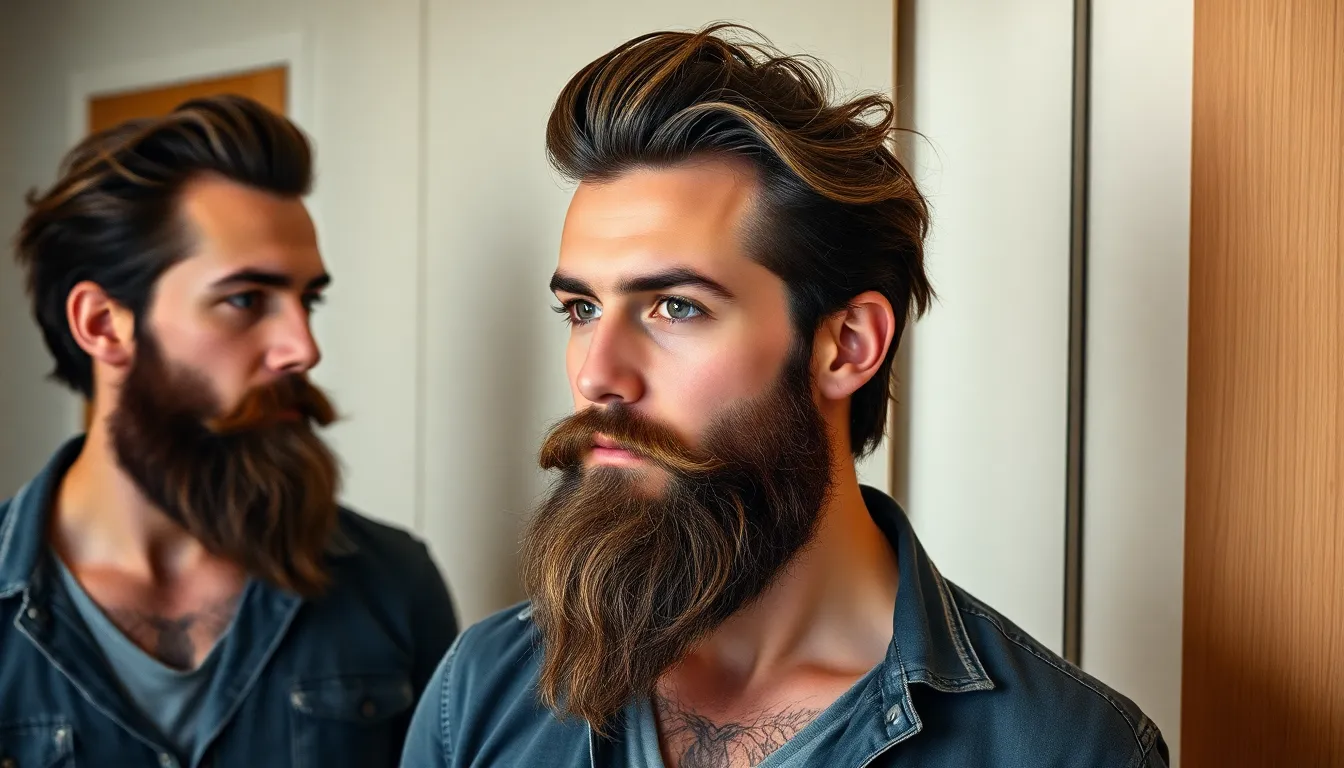
We’ve established that long beards offer incredible versatility, but selecting the right style for your unique features makes all the difference. Understanding how to match your beard to your face shape and hair texture ensures you’ll achieve the most flattering and manageable look possible.
Matching Long Beard Styles to Face Structure
Oval faces benefit from nearly every long beard style available. The balanced proportions of oval faces make them ideal candidates for popular styles like the Garibaldi beard and Viking beard.
Square faces require styles that soften sharp jawlines through rounded edges. Opt for the Bandholz beard or a long goatee with a full mustache to create a more balanced appearance.
Round faces need length and definition to elongate facial features. Choose styles like the Razor-sharp or Ducktail beard while trimming the sides to create vertical lines that stretch the face.
Diamond faces work best with softer beard styles that balance angular jawlines and sharp cheekbones. Full beards or goatees provide the perfect solution for this face shape.
Heart faces require voluminous styles that add bulk to the bottom half of the face. Full beards help balance top-heavy proportions by creating visual weight in the lower portion of your face.
Adapting Styles for Various Hair Textures
Thick hair allows for more elaborate styling options and can support braided or intricately designed beards. Braided Viking beard styles work particularly well with this hair texture.
Thin hair requires careful styling to avoid overly thick or bushy appearances. Focus on styles that create defined edges without adding unnecessary bulk to your beard.
Curly hair needs extra attention to maintain manageability and definition. Use beard balm or oil to keep curls under control while adding structure to your overall beard shape.
Regular trimming remains essential for maintaining the shape of all long beards regardless of face shape or hair texture. Quality products like beard oil and balm keep your beard healthy and well-groomed throughout the styling process. Consider complementary hairstyles like man buns or undercuts to enhance your chosen long beard style.
Conclusion
Growing a long beard isn’t just about letting your facial hair run wild – it’s about choosing a style that complements your face shape and lifestyle while committing to proper maintenance. Whether you’re drawn to the rugged Lumberjack look or the sophisticated Garibaldi we’ve shown you that each style requires dedication and the right grooming approach.
Remember that achieving your ideal long beard takes time patience and quality products. From daily brushing routines to strategic trimming techniques the journey to a magnificent long beard is as rewarding as the destination itself.
Your beard is a reflection of your personality and style so choose the approach that feels most authentic to you. With the right knowledge tools and commitment you’ll master the art of long beard grooming and enjoy the confidence that comes with a well-maintained magnificent beard.
Frequently Asked Questions
What is the best long beard style for beginners?
The classic full beard is ideal for beginners as it’s versatile and works with most face shapes. It requires basic maintenance like daily brushing, weekly trimming, and regular application of beard oil. This style allows you to learn fundamental grooming techniques while achieving a sophisticated, masculine look that projects strength and maturity.
How long does it take to grow a long beard?
Growing a substantial long beard typically takes 3-6 months, while achieving a “yeard” (year-long beard) requires 12 months of consistent growth. The first three months are often the most challenging due to itchiness and uneven growth. Patience and consistent grooming are essential during this period.
What face shapes work best with long beards?
Long beards complement oval, square, round, and heart-shaped faces effectively. The Garibaldi style suits oval and rectangular faces, while the Bandholz works well for square faces. Round faces benefit from styles that add length, and heart-shaped faces look great with fuller bottom sections that balance facial proportions.
What essential tools do I need for long beard maintenance?
Key tools include a natural boar bristle brush for detangling, a quality comb for shaping, professional scissors or electric trimmers for length control, beard oil for softness, beard balm for styling, and specialized beard shampoo. These tools ensure proper grooming and maintain beard health and appearance.
How often should I trim my long beard?
Long beards require trimming every 2-4 weeks to maintain shape and remove split ends. Weekly light trimming helps keep the style neat, while more substantial shaping should be done monthly. Focus on maintaining the desired silhouette while preserving length, and consider professional grooming every few months.
What’s the difference between Viking and Lumberjack beard styles?
Viking beards emphasize cultural heritage with thick, full growth and seamless mustache connection, often featuring braids or pointed shapes. Lumberjack beards focus on rugged, naturally wild aesthetics with strategic shaping. Both require consistent grooming but represent different philosophical approaches to masculine facial hair styling.
Can thin hair achieve impressive long beard styles?
Yes, thin hair can create striking long beards with proper techniques. Focus on defined edges, use volumizing products, and consider styles like the Ducktail that create the illusion of thickness through strategic shaping. Regular grooming and quality products help maximize your natural hair density for impressive results.
What’s the most challenging aspect of growing a Wizard Beard?
The Wizard Beard’s ultra-long length requires exceptional patience and commitment, often taking 2-3 years to achieve. The biggest challenges include managing daily activities, preventing tangles, and maintaining hair health at extreme lengths. Protective care, minimal trimming, and comprehensive conditioning routines are absolutely essential for success.
